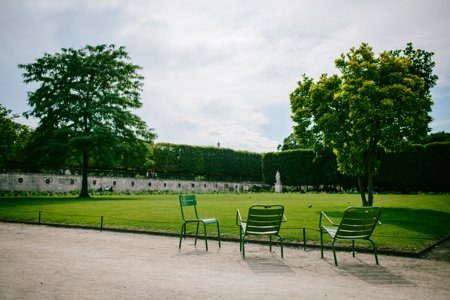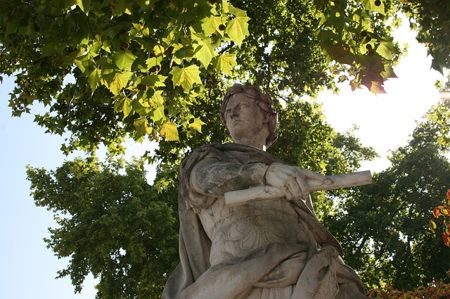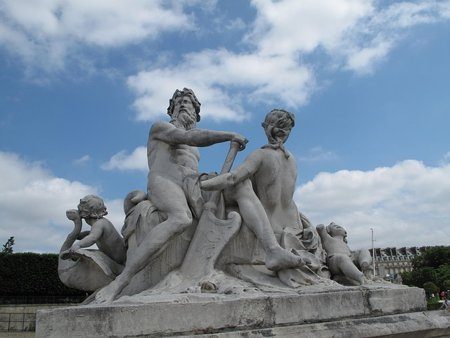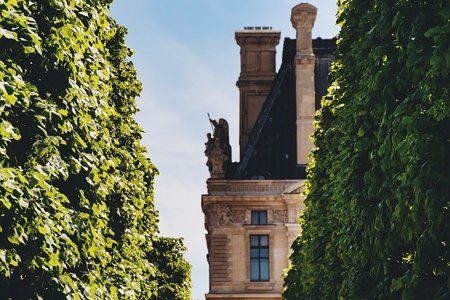Many find it difficult to believe that the beautiful Tuileries garden was actually a site of a factory that manufactured tiles. The luscious and proportioned garden lies in the first arrondissement of Paris… a Parisian green lung sandwiched between Rue de Rivoli, Louvre and the Place de la Concorde. The garden runs from Place du Carrousel to the Place de la Concorde and is one of the best places for nature watching, walking and picnics.
The design of the garden creates the impression of an endless stretch of greenery as it’s aligned with Champs Elysees. French monarchs (notably Louis IV) looked out of the Tuileries Palace windows to admire their perfectly beautiful kingdom. Two terraces with incredible views run alongside…the one nearer the river belongs to the Orangerie and another one (Feuillants) belongs to Galerei jeu de Paume.

The water pool sizes increased as they receded into the distance and planting beds and gravel paths are painstakingly arranged. Lots of bosquets (plantations of 5 trees) flanks one end of the gardens (the site of the now razed Tuileries Palace) and fountains and parterres add to the symmetrical effect. Even if you are not a design and architecture lover you will appreciate the “bilateral symmetry” of the gardens and the labour that must have produced it.
History
It all started in 1559 when the famous queen of king Henry II Catherine de Medici moved to Louvre Palace after her husband’s death. In 1564 she commissioned a new palace and an enclosed garden that was about 500 m long and 300 m wide. That garden was used for hosting royal parties and marriages and its flower arrangements and vineyards were a source of admiration in ancient Paris.
The garden went on to indulge many French monarchs and their whims. King Henry III tried to promote sericulture here by planting mulberry trees and built a new lake and moat. Louis XIII kept a menagerie of animals and used it for hunting. However it was Andre Le Notre ; an architect hired by Louis XIV who developed the widely admired landscaped symmetrical design that Tuileries Grand Carre is now famous for…this is a garden that impresses best from a bird’s eye view.
Louis XV acquired most of the statues that now grace the garden, and then the practice of hosting fireworks shows and parties in the garden was started. Post the French revolution the garden became the “Jardin National” of French Republic and in 19th century Napoleon made some significant additions to the garden besides establishing the charming rue de Rivoli. The Tuileries palace was ransacked in 1870 when the Paris commune uprising happened and the vacant site was integrated into the garden.
Tuileries saw tumultuous times during the two world wars but between all this it acquired the famous Water lily series by Monet and the “Orangerie” was established as a western art gallery. The Grand Louvre project happened in 1994 and the lovely Carrousel gardens were designed. Notable sculptures of modern artists like Jean Dubuffet, Magdalena Abakanowicz,, Henri Laurens, Étienne Martin, Henry Moore etc. were added to the garden.
Right now the Tuileries gardens span over 22 hectares and are the best place to seek rest, relaxation and some moments with nature in the heart of busy Paris. It has everything from numerous fountains to famous statues to a nice carrousel and a large Ferris wheel so it’s basically one of the best family oriented destinations in the city. Exploring the gardens becomes easier when you understand the principal areas and their offerings.
Structure and Notable Areas
Carrousel Gardens
The piece of garden sandwiched between Louvre wings and the erstwhile Tuileries Palace was used extensively for cavalry marches and military shows in Napoleon times. Its principal feature is the Arc de Triomphe du Carrousel that has lots and lots of sculptural depictions of his battles by the artist Jean Joseph. Look out for the 21 statues by Artiste Mailol. The Allee Centrale (main road) of the garden goes up to the arc and there is a famous stall here called ‘Kioske Paul’ (ideal place to take away some sandwiches and bottled water).
Notice that the Arc of Triumph here is symmetrically aligned to the Concorde obelisk, and the central line of Champs Elysee avenue with the bigger Champs Elysees Triumph Arc (that one is double the size). Along this road there is a large water basin with a big fountain known as Grand Bassin Rond. Many free chairs lie nearby so this is a good place to relax.

Terrasse and Ancient Moat
There is an elevated terrace that stands between the Carrousel and the rest of the garden that acts like a barrier and a viewpoint….it’s designed by Ming Pei. Look out for the gorgeous super-sized vases that were sourced from the Versailles palace and the Aristide Maillol statues. Look beyond the vase and you will be able to see the façade of Pavilion de Marsan in the background.
Take the stairs that lead down to the moat that’s named after Charles V (the monarch who rebuilt Louvre). If you look carefully to the west there are scars of the battle of French Religious wars. The moat now contains statues sourced from the façade of the Tuileries palace and bas reliefs that date back to 19th century.
Large Square/ Grand Carre (open part of Tuileries)
This part of the garden is in the east and it is laid down formally in the 17th century style. More than 20 gardeners tend to this 7000 sq. foot area and the saplings and bulbs that are planted here are sourced from horticultural hubs like Saint Cloud gardens (about 70,000 new ones are required annually).
This area is filled with antique 19th century statues most notable of which are the Nymphe, Diana the Huntress and a couple of statues depicting a tiger. The round pond in this part of the garden was a part of the private property of Louis Philippe and Napoleon III and are distinct from the rest of the Tuileries. Right now the whole pond is surrounded by statues that are interestingly arranged; violent poses alternate with quiet ones….the whole series is done by different artists. The most important ones are Misery, Good Samaritan, Medee, La Comedie, Oath of Spartacus, and Cain after Killing Abel etc.
There are numerous smaller ponds in this area and in the warmer months one can unusually see model boats (can be controlled by remote control) floating in the pond near Arc de Triomphe du Carrousel. …much to the amusement of visiting kids.
The North eastern part of the Grand Carre has the famous Ferris wheel and a ride on this should definitely be a part of your Tuileries trip.
Le Grand Couvert
The Grand Covert is covered with a stunning number of trees and possesses two low slanting walls that contain statues which are survivors of the French revolution. This area also has some contemporary statues made by modern sculptors like Paul Belmondo, Guiseppe Penone, Daniel Dezeuze, Eugene Dodeigne amongst others. There are two similar looking ponds here that flaunt plaster copies of famous statues the originals of which are now housed in the Louvre museum.

Orangerie/ Musee de l’Orangerie
The old 1852 dated Orangery that shielded the citrus fruits of the Tuileries against the winter air is now a beautiful museum. This lies at the south western end of the garden close to the river Siene and its river facing wall is made of glass while the garden facing one is constructed of stone. Musee de l’Orangerie is best known for its lovely Claude Monet series of “Water Lilies”….this is a series of 250 paintings created by Monet and aptly christened “Les Nympheas”.
Then there is the Jean Walter and Paul Guillaume ….works of art by famous artists like Matisse, Modigliano, Picasso, and Renoir etc. Till 1970 the Orangerie was one of the highest cultural hubs of Paris but post the arrival of entre Pompidou, muse d’Orsay, Louvre etc…its eminence paled comparatively. This isn’t a huge museum but the interiors are artistically designed and the exterior refurbished by star architect Michel Goutal.

The terrace of the Orangerie also has some spectacular sculpture by Auguste Rodin besides a modern piece by Alain Kirlii. Look out for the fantastic view of the Roseraie, Octagonal Basin, Fer a Cheval etc.
Incidentally the two museum building exteriors (Musee de l’Orangerie) and Gallerie du Jeu de Paume are exactly the same…they were both commissioned by Napoleon.
Jeu de Paume
Jeu de Paume lies on the Terrasse des Feuillants (North West terrace of the Tuileries) and was conceptualized by legendary architect Viraut. Though originally meant to be a tennis court for Napoleon it became an annexure of the Luxembourg Palace museum where it displayed contemporary art sourced from outside France. A lot of its important collections have now been exported to Musee d’ Orsay but many good exhibitions of modern art (majorly film and photography) are held here periodically. The Terrasse des Feuillants has a fantastic statue of a Lion and Lioness fighting over a boar….this gorgeous creation by Auguste Nicolas Cain is only one of the many animal statues around.
Activities
Every year the Tuileries garden sees the famous Fete des Tuileries from June to August. Numerous joyrides, pony walks, stalls and snacks sellers flood the garden and it becomes a shopping, eating and entertainment hotspot for the Parisians. From late November there is a Christmas market that’s held along the banks of rue de Rivoli …the gardens become pretty crowded around this time.
The park is a great picnic spot for feeding birds… plenty of ducks and pigeons around. You will find lots of locals with their kids here so this is sort of a great place for observing local life. There are at least two children’s play areas and one of them has trampolines. All the statues have good signage identifying the author and (sometimes) the meaning. Checking out the whole garden thoroughly will at least take a couple of hours. One can easily spend a day here enjoying picnics and museum visits or if it’s used as a resting spot in between nearby attraction visits.
Right at the Place de Concorde entrance of the garden there is a supersized Ferris wheel that runs from 10.30 a.m. in the morning to 12.00 a.m. tickets cost about 8 euros and you can enjoy fantastic views of the city.
Open Hours, Tours & Tickets
One of the best things about the Tuileries gardens is that it has free unlimited access. So anytime you are in the vicinity and you want to rest your legs or enjoy an open air picnic or simply look at the flowers etc…come right in.
The Tuileries is open from last Sunday of March to 31 May & 1’st September to the last Saturday of September: Timings- 7am to 9pm.
From the last Sunday of September to the last Saturday of March: Timings- 7.30am to 7.30pm.
From 1st June to 31 August the Tuileries is open from 7am to 11pm. (fete des Tuileries) .
You can find many tours of Tuileries Garden and Louvre (with option for skip the line entry ticket) and book online through this Viator site.
The guards keep telling visitors to clear the grounds half an hour before the gardens close formally. There are no toilets inside the Tuileries gardens but there are ones outside the perimeter of the garden and near the entrance gates.
Location & How To Reach
The Tuileries is framed on each side by notable attractions; Rue de Rivoli to the north, Seine river to the south, Place de la Concorde to the west and the Louvre to the east.
The nearest RER station to the Tuileries garden is the Musee d’ Orsay stop. The nearest subway stop are the Concorde and the Tuileries garden stops. You can take the metro lines 1, 7, 8 and 12 to Concorde and the Tuileries ….Palais Royal Musee du Louvre stop is also nearby.
There are several bus stops near the Tuileries and you can take the bus numbers 21, 24, 27, 42, 68, 69, 72, 73, 81, 84, 94, 95 to reach the gardens. The Paris open topped hop on hop off buses also stop nearby
The traffic near this area is deadly…while riding the Ferris wheel you can glimpse the furious flow of it from a distance. Avoid driving to this destination and use metro transport preferably.
It’s possible to access the gardens via 3 entrances; 206 rue de Rivoli, place de la Concorde and place du Carrousel.
The Tuileries garden has 3 in-house restaurants; La Terrasse de Pomone, Café des Marronniers and Le Médicis
The La Terrasse de Pomone is open all year and all times according to the opening hours of the Jardin des Tuileries. The Café des Marronniers is open all week from 7am – 9pm and the Restaurant Le Médicis is open from 10.30am to 7pm all week. Apart from these there are several food carts scattered throughout the gardens. There are several other restaurants around where you can enjoy a nice meal. You can enjoy the crepes at Food Breizh at Promenade des berges de Seine and the macaroons at Pierre Herme on rue Cambon. And there are L’Ecrin at Place de la Concorde, Maxim’s at rue Royale and Ledoyen at avenue Dutuit Champs Elysees.
You can combine your Tuileries garden visit with a trip to the Louvre Museum, Seine River Bank, Musee d’ Orsay (cross the river and walk a short while). Exploring the Place de la Concorde (the execution of Louis XVI happened at this square) and its old Egyptian obelisk is a good activity. The nearby Place Vendome with its Vendome column and the bevy of lovely shops is also a good place to explore. The Grand and petit Palais with their temporary exhibitions, science museum and rich stores of paintings and antiques are also at a walking distance as well as the Champs Elysees area.
Address
113 Rue de Rivoli, 75001 Paris
Information Phone: +33 (0) 1 40 20 53 17
For queries about accessibility/ differently abled phone: +33 (0) 40 20 59 90
Wheelchairs, braille signage and other accessibility aids provided on request.
 A travel addict. Still celebrating the day when he quit his high-profile corporate job to pursue his passion for travel writing.
A travel addict. Still celebrating the day when he quit his high-profile corporate job to pursue his passion for travel writing.